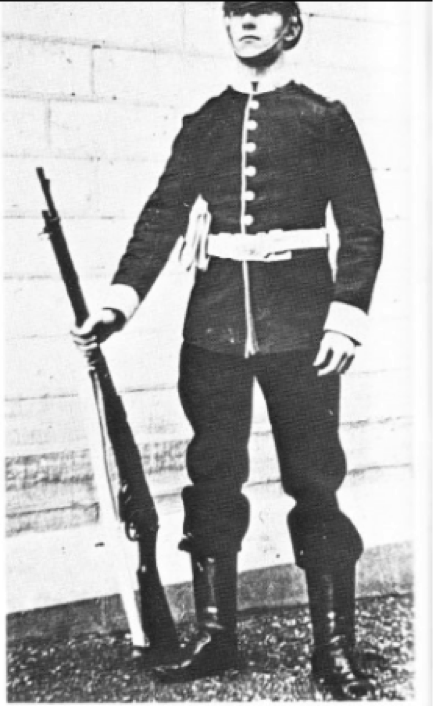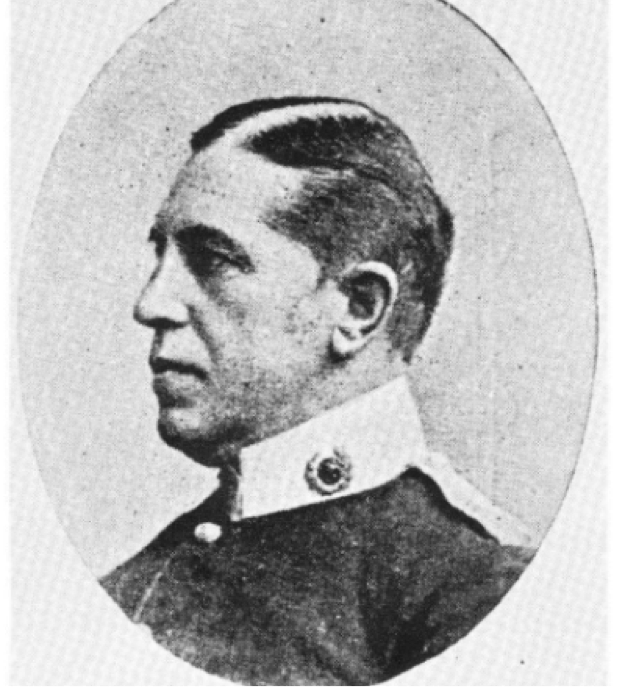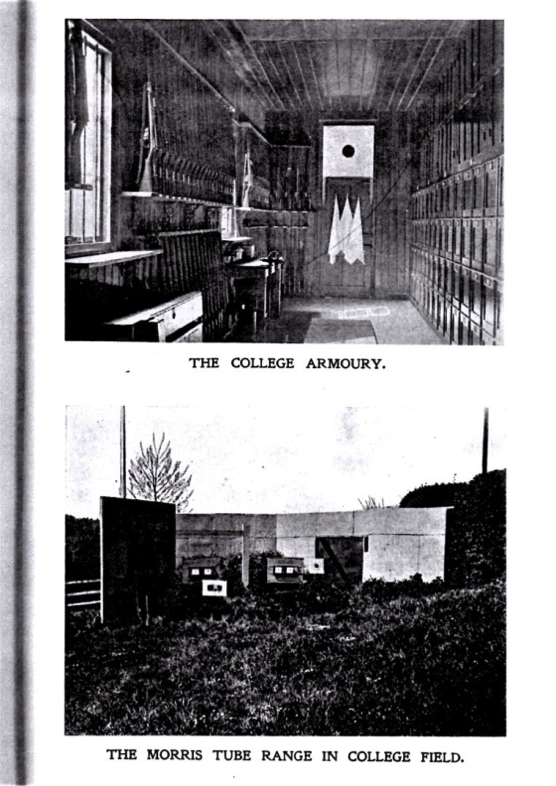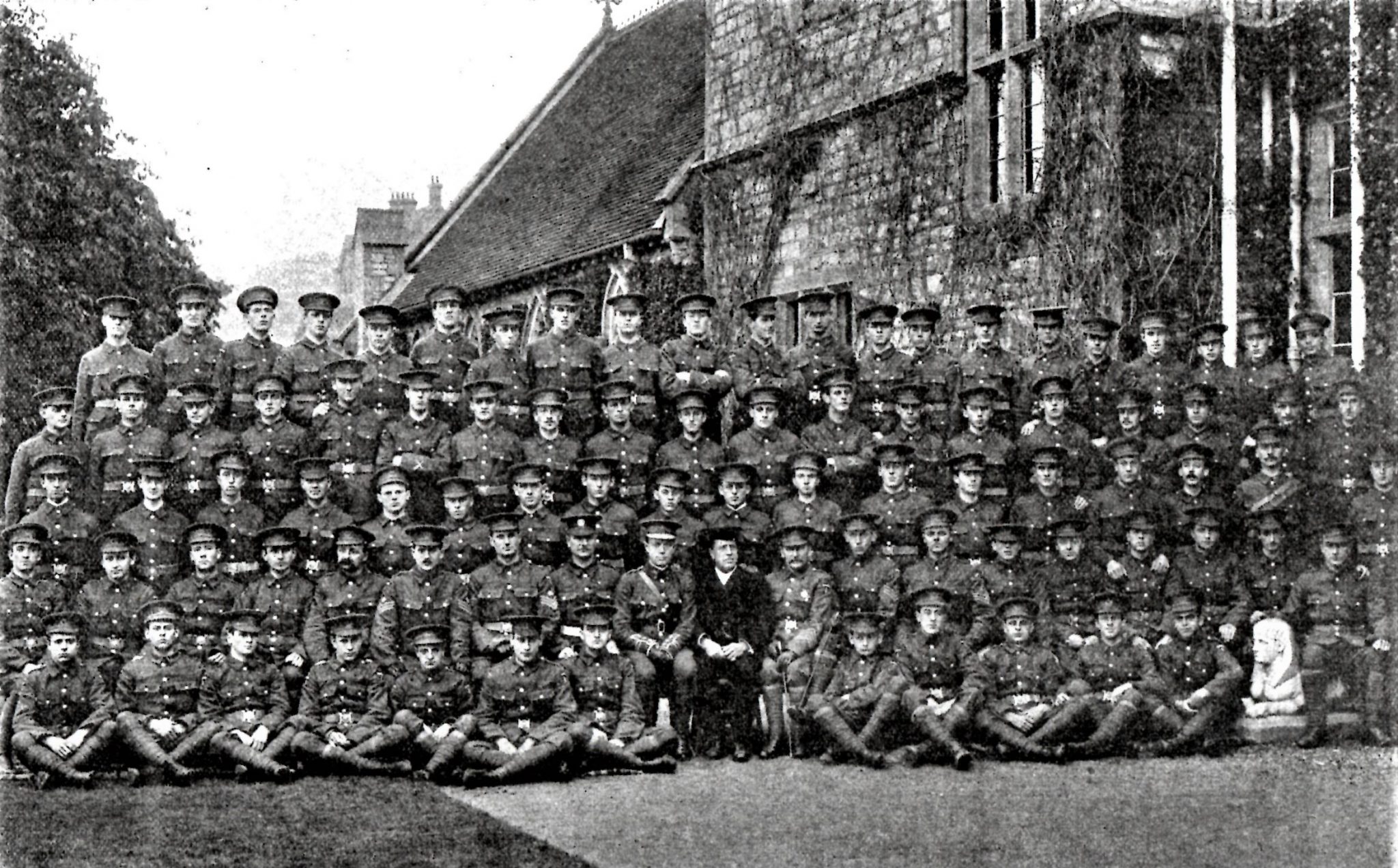The History of the Volunteer Company at Winchester Diocesan Training College
The Volunteer Force, later the Territorial Force, had an important part to play in the lives of our 60 students who died in the Great War. Several of the students, commemorated in the Chapel at the University of Winchester, settled in the local area when their training was complete. When war was declared and they decided to enlist it was understandable that several of them would want to remain with the Regiment that had been an important part of their lives for the two years that they were in College. They had friends and acquaintances in the Hampshire Territorial Force. Some of them had continued as part of the Force when they began teaching, and were on an exercise with the Regiment when war was declared.
The rise of the Volunteer Force, which later became Territorial Companies, started in 1859. There was a circular letter, dated 12th May from the War Office to the Lords Lieutenant of the English Counties which resulted in the raising, over the following two years, of various Rifle Corps. One of these was the 1st Hants Rifle Corps, based in Winchester.
On the 24th February 1875 it was decided to form a College Company. This was authorized by the War Office and given the title The Winchester Diocesan Training College Corps, or the 24th Rifle Corps. The Volunteer Company at Winchester was part of the 1st Volunteer Battalion Hampshire Regiment.
The original uniform was a light grey with green facings and black braiding. By the time the College Force was formed they were armed with the Snider rifle, the first breech loading rifle of the British Army. Drill was carried out on the Ditch (or Dytche), a College field, while shooting practice took place at Teg Down. There were various locations used for annual camps. The College Principal was commissioned into the Company. In 1877 the uniform changed to scarlet with black facings, eventually changing to fit in with the regular battalions of the Hampshire Regiment. A shooting club was formed in 1880, and in the same year the Volunteer Force became known as I’ Company of 1st Hampshire Rifle Volunteer Corps. The College Company included the entire student body and several staff members and former students.
Henry Martin Principal 1878-1912 in the uniform of a Major in the 1st Hampshire Volunteer Force From the Hampshire Record Office archives
In 1881 the College Company attended camp and paraded at the Great Volunteer Review in Windsor Park. Each year they attended a camp which included exercises, manoeuvres, parades, drills and competitions. These camps were held at various venues around the south of England included Salisbury Plain and Hayling Island.
In 1885 the Volunteer Force, now known as the 1st Volunteer Battalion Hampshire Regiment, replaced the Snider rifle with the Martini-Henry rifle, to be replaced by the Lee-Metford magazine rifle in 1897. Also in that year a new armoury was erected at the Training College. It was fitted out with racks for rifles and lockers for uniforms and equipment. It was located south of the student common room. The following year the annual camp was held in the New Forest. The Cyclists Section represented the battalion in the military skills competition that was held every year.
The importance of the Volunteer Force in College life is illustrated by how quickly their military training began after entering College. The students started at the College half way through September. As soon as possible after that they were putting in two drills a day from 2pm-3pm and 3pm-6pm until they had completed at least 30 drills and were deemed to be efficient, the aim being to achieve this by the end of October. This of course was on top of a full academic timetable. The Volunteer Force was inspected as part of College Inspections. In 1893 the Adjutant told the Inspector that the College Company was the best within the Volunteer Corps and that they had the best marksmen.
In 1908 the Volunteer Force ceased to exist and in its place the Territorial Force was formed. The College Company became B’ Company of the 4th Territorial Battalion of the Hampshire Regiment. This was more than just a change of name. Students previously had automatically been enrolled in the Volunteer Force. In the Territorial Force they were enlisted. This was a significant change and with it came different conditions of service. The students were subject to a more professional system, which included military discipline and more thorough training. These changes meant that membership was no longer automatic, the students were given a choice and not all students chose to enlist.
When war was declared in August 1914, B’ Company was at its annual camp at Bulford on Salisbury Plain. The Company was made up of 104 men, 40 of them being students in their final year. As members of the Territorial Force they were immediately mobilised and remained with the Company on Salisbury Plain. They were joined by the Principal and one of the College tutors. In September they moved back to Winchester where they were billeted at College until December when they were sent to India. Winchester Training College was used by the War Office for the duration of the war.
V S Manley, a Wintonian, wrote in his diary a list of the Wintonians who volunteered for service in Mesopotamia and what happened to them. This was a contemporary account and is not necessarily complete or wholly accurate.
3381 Purkis H S, Pte Jersey Died of disease (whilst a prisoner of war at Kut-al-Amara) 1
1865 Smith Ralph, L Cpl Swindon shot in elbow 21/1/1916 2
3084 Singleton C F, Pte Codford, Wilts Died 3
2167 Bolwell F J W, Pte Radstock Killed
1869 Windust A H, Pte Eastleigh, Hants Survived
2185 Oakley C R, Pte Broseley, Salop shot through shoulder 21/1/1916
1862 Rose H W, Pte Ongar, Essex Killed in action 4
3078 Hurst G T , L Cpl London wounded 21/1/1916
3611 Richardson J J, Pte I.O.W.
3616 Soper W T, Pte Cowes I.O.W.
2195 Tarrant A, Pte Wroughton, Swindon Killed in action
Clifford W O, Pte Charlton
1867 Warne A, Pte Brightstone I.O.W. Killed in action
2199 Woodfield A, Pte Died of disease 8/6/1916
Rodd G W Shanklin I.O.W.
Butcher J, Pte Canterbury
(Westminster Training College “ 3081-Pittuck B, Pte “ London)
In the photograph of I’ Company there is a small stone sphinx. There were two of these, which stood on either side of the main terrace entrance. According to Martial Rose these were frequently moved to different places around the College, presumably by high spirited students, and were eventually fixed firmly to the land;
But not firmly enough, for they finally disappeared altogether.
Photograph from Hampshire Record Office archives
Footnotes
- Purkis was not amongst the soldiers besieged at Kut. He did die as a prisoner of the Turks but we have no information as to where he was held.
- Smith, Oakley and Hurst were all injured at the Battle of Umm-el-Hannah.
- Singleton and Bolwell died of disease as prisoners of the Turks after being besieged at Kut-al-Amara.
- Rose, Tarrant and Warne were all killed in action at the Battle of Umm-el-Hannah
Sources
Rose, M. (1981). A history of King Alfred’s College, Winchester 1840-1980. London: Phillimore.
Manley, V.S. (1916-1919). A Khaki Diary, (Volumes 1-6, Vol. 4 missing), Hampshire Record Office Archive, 47M91W/Q3/6/1, 47M91W/Q3/6/2, 47M91W/Q3/6/3, 47M91W/Q3/6/5, 47M91W/Q3/6/6, Winchester.
Thomas, Capt. R.A., ed., The History of The Volunteer Company at the Training College, Winchester. Hampshire Record Office Archive, 47M91W/R2/5, Winchester.
| University of Winchester Archive “ Hampshire Record Office | ||
| Reference code | Record | |
| 47M91W/ | P2/4 | The Wintonian 1899-1900 |
| 47M91W/ | P2/5 | The Wintonian 1901-1902 |
| 47M91W/ | P2/6 | The Wintonian 1903-1904 |
| 47M91W/ | P2/7 | The Wintonian 1904-1906 |
| 47M91W/ | P2/8 | The Wintonian 1905-1907 |
| 47M91W/ | P2/10 | The Wintonian 1908-1910 |
| 47M91W/ | P2/11 | The Wintonian 1910-1914 |
| 47M91W/ | P2/12 | The Wintonian 1920-1925 |
| 47M91W/ | D1/2 | The Student Register |
| 47M91W/ | S5//5/10 | Photograph of 5 alumni in Mesopotamia |
| 47M91W/ | Q3/6 | A Khaki Diary |
| 47M91W/ | B1/2 | Reports of Training College 1913-1914 |
| 47M91W/ | Q1/5 | Report and Balance Sheets 1904- 1949 |
| 47M91W/ | R2/5 | History of the Volunteers Company 1910 |
| 47M91W/ | L1/2 | College Rules 1920 |
| Hampshire Record Office archive | ||
| 71M88W/6 | List of Prisoners at Kut | |
| 55M81W/PJ1 | Managers’ Minute Book 1876-1903 | |
| All material referenced as 47M91W/ is the copyright of The University of Winchester. Permission to reproduce photographs and other material for this narrative has been agreed by the University and Hampshire Record Office. | ||




